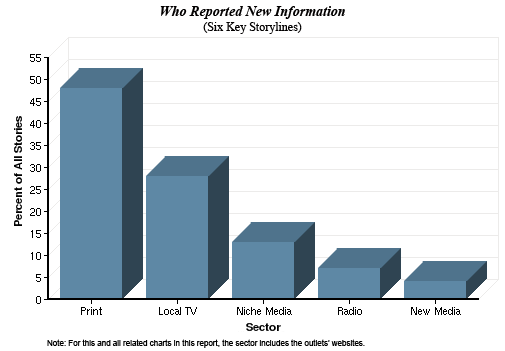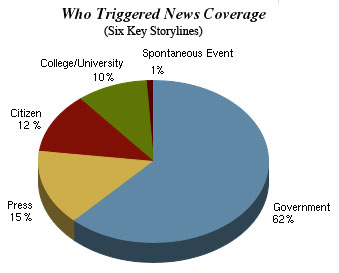
Where does the news come from in today’s changing media?

Who really reports the news that most people get about their communities? What role do new media, blogs and specialty news sites now play?
How, in other words, does the modern news “ecosystem” of a large American city work? And if newspapers were to die—to the extent that we can infer from the current landscape—what would that imply for what citizens would know and not know about where they live?
The questions are becoming increasingly urgent. As the economic model that has subsidized professional journalism collapses, the number of people gathering news in traditional television, print and radio organizations is shrinking markedly. What, if anything, is taking up that slack?
The answers are a moving target; even trying to figure out how to answer them is a challenge. But a new study by the Pew Research Center’s Project for Excellence in Journalism, which takes a close look at the news ecosystem of one city suggests that while the news landscape has rapidly expanded, most of what the public learns is still overwhelmingly driven by traditional media—particularly newspapers.
The study, which examined all the outlets that produced local news in Baltimore, Md., for one week, surveyed their output and then did a closer examination of six major narratives during the week, finds that much of the “news” people receive contains no original reporting. Fully eight out of ten stories studied simply repeated or repackaged previously published information.
And of the stories that did contain new information nearly all, 95%, came from traditional media—most of them newspapers. These stories then tended to set the narrative agenda for most other media outlets.
Indeed the expanding universe of new media, including blogs, Twitter and local websites—at least in Baltimore—played only a limited role: mainly an alert system and a way to disseminate stories from other places.

New technology was more prevalent as a way for media—both traditional and new—to break news more quickly. The Web is now clearly the first place of publication.
And this faster dissemination of news was tied to three other trends. As news is posted faster, often with little enterprise reporting added, the official version of events is becoming more important. We found official press releases often appear word for word in first accounts of events, though often not noted as such.
In the growing echo chamber online, formal procedures for citing and crediting can get lost. We found numerous examples of websites carrying sections of other people’s work without attribution and often suggesting original reporting was added when none was. We found elements of this in several major stories we traced.
And sometimes old stories that were already obsolete were posted or linked to after events had changed and the original news site had updated them.
These are some of the results of a close examination of the media covering Baltimore, MD, during the week of July 19-25, 2009.
Among the findings:
Then PEJ did a deeper, secondary analysis of six major story threads during the target week, charting the course of the story, where it started and how it grew, story to story, minute-by-minute. The six narratives were selected from among the biggest of the week to reflect a range of different kinds of stories, from breaking news about crime, to state government budget cuts to stories that clearly involved the use of new media. PEJ identified which stories contained new information or added new angles and which sources and people drove the narrative. And Twitter feeds about the news were tracked as well, to see who was using that technology to communicate. That analysis identified 10 additional outlets that passed information along and 15 outlets that offered Twitter updates on the major storylines of the week.
Those six major storylines are provided as detailed chapter narratives of their own in this study, allowing a reader to examine exactly how each story broke, the flow of each narrative through the course of the week, and the lessons it revealed about the news system in the city.
The six storylines included:
This study is only one attempt at trying to understand who is producing news and the character of what is produced. Additional reports could tell more. But this snapshot was in many ways a typical week—marked by stories about police shootings, state budget cuts, swine flu, a big international soccer game in town and a mix of fires, accidents, traffic and weather.
The array of local outlets within this snapshot is already substantial, and as times goes on, new media, specialized outlets and local bloggers are almost certain to grow in number and expand their capacity, particularly if the Sun and other legacy media continue to shrink. New outlets such as local news aggregators, who combine this increasingly mixed universe into one online destination, have cropped up in some other cities such as San Diego. There is a good deal of innovation going on around the country, much of it exciting and promising. But as of 2009, this is what the news looks like in one American city.

Of the more than four dozen outlets identified as producing original content about local events in Baltimore, there are four local TV stations, all with their own websites. There are five general interest newspapers: the Baltimore Sun, City Paper, Towson Times, the Washington Post and the Baltimore Times, which focused on African American culture, as well as two long-standing specialized papers—the Daily Record and the Baltimore Business Journal. There are also four general interest websites in town, from the Investigativevoice.com, a local watchdog reporting website started by former Baltimore Examiner employees, to BaltimoreBrew.com, a local news website produced mostly by former Baltimore Sun staffers. There are five local blogs, two of which focus on crime, one called Inside Charm City, a hyperlocal general interest blog produced by a single person. And there are more than 30 that exist inside the universe of the Baltimore Sun newspaper website.
That first level analysis found that, over those three days, these media produced 715 different stories about local events in the city. Those stories came from 41 different outlets. Twelve outlets produced nothing.
Local TV newsrooms produced more content than any other sector, an average of 73 stories per station (a total of 291 stories either in broadcast or on their websites out of the three day sample of 715). That was followed closely by newspapers. The five papers studied produced 186 stories during these three days, or 37 per outlet.
Yet the quantity of stories produced does not tell everything about their nature.
The new media content in new media, on the other hand, was highly local and mostly locally produced, though, as we will see, it was often brief and derivative of other news accounts. More than eight out of ten of the postings or stories (85%) were locally focused.
The level of original work also varied. Eight out of ten newspaper stories (80%) were straight news accounts written by local staffers.
In television, there was also less original content from staff reporters. Roughly a third the stories, 34%, were edited packages featuring correspondents doing the reporting (the TV equivalent of an original staff written story), and another 13% were anchors narrating a taped package that did not feature a correspondent from the field. But more than a third 36% were “anchor reads” and “tell stories,” often material from wire services.
In radio there was little of what would be considered reporting. Roughly half the segments were anchors doing monologues, and 38% of the segments involved the host interviewing a guest or a caller. There was no original reporting found, either in talk radio or in the news inserts and radio headlines that were produced during the periods studied (during the 7 a.m. drive time hour).
Looking at the topics covered, too, the news agendas of these outlets were strikingly different. The world one encounters differs dramatically depending on where one seeks his or her information.
To go deeper, however, to see how the ecosystem moved, how information traveled from one sector to another, who initiated the news and who was first to transmit and frame the narratives that the rest of the media followed, the study also took a look at six of the major stories of the week more closely.
1. The proposal by Governor Martin O’Malley to cut $300 million from the state budget, or about 40% of the total cuts he sought to make from the state’s $14 billion budget.
2. A shooting incident in which a 34-year-old Baltimore man, apparently high on the drug Ecstasy, terrorized two former female companions and then shot two city police while being wounded and apprehended himself.
3. The announcement that the University of Maryland, Baltimore had been selected as one of eight sites nationwide that would test the new H1N1 vaccine for the National Institutes of Health.
4. The auction of the historic Senator Theater, an old movie house in north Baltimore that continued to fight for survival while defaulting on its loans.
5. A plan by the Maryland Transit Administration to put listening devices on buses died a sudden and conclusive death once the press discovered it.
6. A series of different events intertwined and formed the biggest narrative of the week—framed by an investigation by the local newspaper—involving how the state and the city approached juvenile justice and incarceration.
Footnotes
1. According to Factiva, the Sun produced 23,668 2 stories on all topics from January 1 through December 31, 2009 and 34,852 in the same time frame in 1999 and 86,667 in 1991.
2.Three days of content was analyzed for the study. This included content from July 20, 22 and 24, 2009.
3. Early evening local TV newscasts were recorded and analyzed. For WMAR, WJZ and WBAL, we examined the 6 p.m. newscast. WBFF, the Fox affiliate, does not air news at 6 p.m., so we examined its 5:30 p.m. newscast.
4. A third commercial station, WJZ, could not be captured by PEJ.
5. This analysis examined the early evening newscasts of ABC affiliate WMAR, CBS affiliate WJZ, NBC affiliate WBAL and Fox affiliate WBFF
6. Add accidents (another 13%), and more than a third of all the coverage related to public safety—numbers that track closely with research on local TV that PEJ has produced over the years. And if one looked at the stories that led the newscasts, crime and accidents made up roughly six out of ten stories (58%). That number, incidentally, is also identical to that we found in a five-year study of more than 33,000 stories in local TV news examining 150 stations around the country. “We Interrupt This Newscast: How to Improve Local News and Win Ratings, Too.” Columbia University Press, 2007, p. 33.